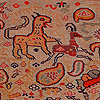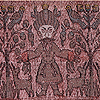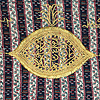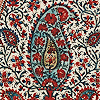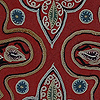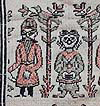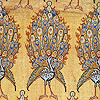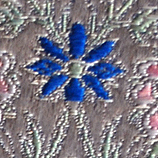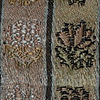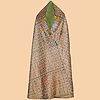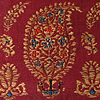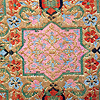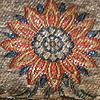The paisley pattern, though derived from Kashmir shawls and their European imitations, is a variant of an ancient and versatile design theme. The teardrop, or elongated oval with one end tapering to a point, can be traced back to Pharaonic, Chaldean, and Assyrian stone carvings, ancient Greek ceramics, and medieval Coptic, Central Asian, and European textiles. It features variously as lotus bud, tree-of-life, ivy or acanthus leaf, cone, palm frond or cypress, occasionally with the bent-over tip that is the paisley’s defining characteristic.
As we know it today, however, the paisley emerged much later, in the shawl design of Kashmir, and perhaps contemporaneously in Persia, in the termeh, the woven shawls of Meshad, Kerman, and Yazd. It developed out of the single, somewhat naturalistic bloom, a restrained and graceful form that in the seventeenth century became the favorite motif of Mughal courtly art. Applied to the shawl fabrics for which Kashmir and Persia were already famous, the single flower evolved into a bush, or a bouquet of flowers, growing ever more elaborate and stylized. By about the second half of the eighteenth century, it assumed its characteristic shape, becoming, in myriad variations, the predominant motif of shawl design. In Kashmir it is usually called buta (Persian boteh, a shrub); and one version is still called shah-pasand, or “emperor’s favorite,” indicating that royal patronage may have played some part in popularizing it. It was quickly incorporated in textile design elsewhere in India, where it is known as kalgi or kalga (plume), badam (almond), or ambi (mango).
By the end of the eighteenth century, imported Kashmir shawls had become high fashion in Europe as accessories to women’s attire rather than shoulder mantles for men, Indian-style. British entrepreneurs started experimenting with “imitation Indian shawls” in the last decades of the century, first in Edinburgh, then in Norwich, copying or adapting the Kashmir designs.
As demand grew, Edinburgh shawl manufacturers started outsourcing work to Paisley which, as home to a long-established textile industry, had a pool of skilled weavers capable of drawing on the experience of Norwich, Edinburgh, and various shawl-manufacturing centers in France, and could take advantage of technological developments, particularly the Jacquard loom. This adaptability, together with good management and easy access to imported raw materials through the ports of the Clyde made Paisley shawls so competitive that in time they eclipsed those of the other British centers. By the mid-nineteenth century, in the English-speaking world, the term “paisley” had become synonymous with shawls, and by extension with the buta design, whether used on shawls or elsewhere.
The paisley retained its popularity even after the shawl fashion came to an end in the 1870s, partly due to the famous London store Liberty’s, many of whose trademark printed fabrics used designs derived from shawl pattern books. In the twenty-first century, it features textiles destined to be made up into clothes from saris and shawls in India to dresses, ties, and scarves in the West as well as on furnishing materials, bone china, and indeed almost any item that calls for a “traditional” form of decoration. Its popularity has endured across the board, from high fashion to high-street kitsch (especially in Scotland). But it does seem a pity that it has come to be known by the name of a town whose weavers though responsible for popularizing it made no significant contribution to its development, rather than by any of the names indigenous to the region where it originated.
